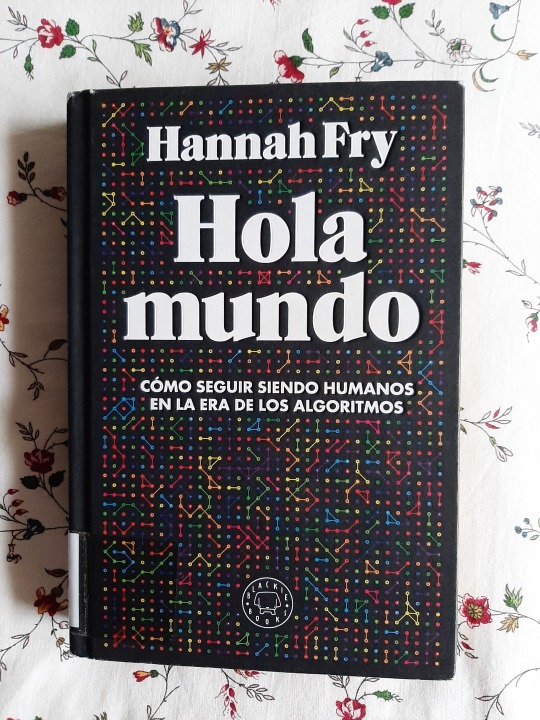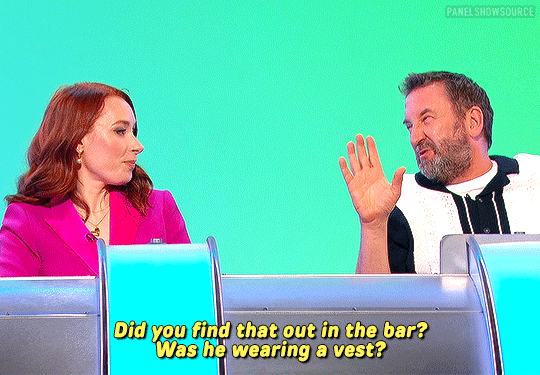#hannah fry
Text



#panelshowedit#wiltyedit#lee mack#david mitchell#charlie brooker#danny jones#shaparak khorsand#hannah fry#would i lie to you#wilty#original#*gifs
119 notes
·
View notes
Text
So this blog's going to be more orderly and journally than my other blog (I know those are not real words just go with it) because I want to use it as a way of keeping in one place all my science ramblings and thoughts.
To start with, these are my main interests within science :
My favourite sciences are biology and physics, chemistry is interesting but I just prefer the other 2
I also like psychology but I am not studying it anymore, I just read about it as a hobby
I am really interested in genetics and neuroscience, particularly epigenetics
I think astrophysics is really cool too
I am interested in autism research but only when it's used to help understanding autistic people not to try and "cure" them. There are so many ethical questions that make it difficult (but I'll discuss more stuff about this in a separate post)
I am enthusiastic about women and girls in science and the idea that everyone should have access to science and that it should be explained in an entertaining and easy to understand way (Hannah fry is one of my heroes and she does this really well)
Overall, I want to become a research scientist to help people and because I think it would be a good way to keep learning (which I enjoy) and to make a difference in the world (and I know maybe that's naive, but it's definitely worth a try)
#science#research science#Autistic science#psychology#biology#physics#chemistry#Hannah fry#stem#women in stem
18 notes
·
View notes
Text

4 notes
·
View notes
Text

Professor Hannah Fry
14 notes
·
View notes
Text
The Secret Genius of Modern Life episode 6
The Secret Genius of Modern Life episode 6: Hannah Fry visits eBay’s authentication centre, where they are waging war against fake high-value trainers. #science
The Secret Genius of Modern Life episode 6: Hannah Fry visits eBay’s authentication centre, where they are waging war against fake high-value trainers. She discovers how American breakfast waffles transformed our trainer soles and how an 18th-century tea set led to the use of celebrity endorsement.
Hannah Fry is a British mathematician, author, and radio and television presenter. She is…

View On WordPress
3 notes
·
View notes
Text

"Es como ese dicho que circula entre los pilotos de las aerolíneas, que sostiene que el mejor equipo de vuelo es el que está integrado por tres componentes, un piloto, un ordenador y un perro: el ordenador sirve para que el avión pueda volar; el piloto, para dar de comer al perro; y el perro, para morder al piloto si intenta tocar el ordenador"
Hola Mundo: Cómo seguir siendo humanos en la era de los algoritmos - Hannah Fry
Hello World: Being Human in the Age of Algorithms
2 notes
·
View notes
Text

READALLABOUTIT!
0 notes
Photo

rothfos & gabler dachten sich bei diesem titel wohl, dass sie dann auch einmal mit absolut allem aufwarten sollten, was die schriftgestaltung von “absolut allem” angeht... das “*gekürzt” ist ihnen dabei leider durch die lappen gegangen. klar, der umschlag ist dem original nachempfunden, und wird doch dem gesamten inhalt nicht gerecht - vor allem dieser unlogischen schatten wegen... und noch einmal - vermutlich vorgabe des verlages - , was sollen diese lobhudeleien von kritiken vorne auf dem einband? lasst doch so etwas weg - es wirkt irgendwo verzweifelt, als ob das buch selbst es nicht in sich hätte. auf der rückseite wäre auch noch platz... (rezension zum buch im vorigen beitrag - und da klärt sich vielleicht der hund auf diesem foto...)
#der ultimative guide zu absolut allem#hannah fry#adam rutherford#verlag c.h.beck#c.h.beck#philosophenstreik#sachbuch#tobias bruns#rezension#kritik#umschlaggestaltung#rothfos & gabler#cover design
0 notes
Text
Is it true that people with aphantasia don’t have an internal monologue?
1 note
·
View note
Text

This comment was left on a video about a public talk on modern developments of automation algorithms that was performed by Hannah Fry.
1 note
·
View note
Text





141 notes
·
View notes
Text
Hello World: Being Human in the Age of Algorithms by Hannah Fry; Quotes
Because there is a tradition among all those who have ever learned to code – a rite of passage, almost. Your first task as a rookie is to program the computer to flash up a famous phrase on to the screen: ‘HELLO WORLD’
No object or algorithm is ever either good or evil in itself. It’s how they’re used that matters. GPS was invented to launch nuclear missiles and now helps deliver pizzas. Pop music, played on repeat, has been deployed as a torture device. And however beautifully made a garland of flowers might be, if I really wanted to I could strangle you with it.
Because the future doesn’t just happen. We create it.
Understanding our own flaws and weaknesses – as well as those of the machine – is the key to remaining in control.
There’s an almost uncountable number of different algorithms. Each has its own goals, its own idiosyncrasies, its clever quirks and drawbacks, and there is no consensus on how best to group them. But broadly speaking, it can be useful to think of the real-world tasks they perform in four main categories:
1. Prioritization: making an ordered list
2. Classification: picking a category
3. Association: finding links Association is all about finding and marking relationships between things.
4. Filtering: isolating what’s important. Algorithms often need to remove some information to focus on what’s important, to separate the signal from the noise.
‘When people are unaware they are being manipulated, they tend to believe they have adopted their new thinking voluntarily,’
If there’s anything we can learn from this story, it’s that the human element does seem to be a critical part of the process: that having a person with the power of veto in a position to review the suggestions of an algorithm before a decision is made is the only sensible way to avoid mistakes. After all, only humans will feel the weight of responsibility for their decisions.
The only problem with this conclusion is that humans aren’t always that reliable either.
If your task involves any kind of calculation, put your money on the algorithm every time: in making medical diagnoses or sales forecasts, predicting suicide attempts or career satisfaction, and assessing everything from fitness for military service to projected academic performance. The machine won’t be perfect, but giving a human a veto over the algorithm would just add more error.
Algorithm aversion. People are less tolerant of an algorithm’s mistakes than of their own – even if their own mistakes are bigger.
Intriguingly, a rare exception to the superiority of algorithmic performance comes from a selection of studies conducted in the late 1950s and 1960s into the ‘diagnosis’ (their words, not mine) of homosexuality. In those examples, the human judgement made far better predictions, outperforming anything the algorithm could manage – suggesting there are some things so intrinsically human that data and mathematical formulae will always struggle to describe them.
And yet, if you build more than one tree – everything can change. Rather than using all the data at once, there is a way to divide and conquer. In what is known as an ensemble, you first build thousands of smaller trees from random subsections of the data. Then, when presented with a new defendant, you simply ask every tree to vote on whether it thinks awarding bail is a good idea or not. The trees may not all agree, and on their own they might still make weak predictions, but just by taking the average of all their answers, you can dramatically improve the precision of your predictions.
This has nothing to do with the crime itself, or with the algorithm: it’s just a mathematical certainty. The outcome is biased because reality is biased. More men commit homicides, so more men will be falsely accused of having the potential to murder.
Unless the fraction of people who commit crimes is the same in every group of defendants, it is mathematically impossible to create a test which is equally accurate at prediction across the board and makes false positive and false negative mistakes at the same rate for every group of defendants.
Weber’s Law states that the smallest change in a stimulus that can be perceived, the so-called ‘Just Noticeable Difference’, is proportional to the initial stimulus.
An outcome like this can happen even if you’re not explicitly using gender as a factor within the algorithm. As long as the prediction is based on factors that correlate with one group more than another (like a defendant’s history of violent crime), this kind of unfairness can arise.
If a diagnostic machine capable of recommending treatments can be built, who should it serve? The individual or the population? Because there will be times where it may have to choose.
The case of medicine is certainly less fraught with tension than the examples from criminal justice. There is no defence and prosecution here. Everyone in the healthcare system is working towards the same goal – getting the patient better. But even here every party in the process has a subtly different set of objectives.
There��s certainly a great deal of valuable information to be had from a camera. A neural network can understand the colour, texture, even physical features of the scene ahead – things like lines, curves, edges and angles. The question is: what do you do with that information once you have it? You could tell the car: ‘Only drive on something that looks like tarmac.’ But that won’t be much good in the desert, where the roads are dusty paths. You could say: ‘Drive on the smoothest thing in the image’ – but, unfortunately, the smoothest thing is almost always the sky or a glass-fronted building. You could think in quite abstract terms about how to describe the shape of a road: ‘Look for an object with two vaguely straight borders. The lines should be wide apart at the bottom of the image and taper in towards each other at the top.’ That seems pretty sensible. Except, unfortunately, it’s also how a tree looks in a photograph.
‘Things that look like autonomous systems are actually systems in which the world is constrained to make them look autonomous.’
Resemblance and identity are not the same thing and never will be, however accurate the algorithms become.
It’s a phenomenon known to psychologists as social proof. Whenever we haven’t got enough information to make decisions for ourselves, we have a habit of copying the behaviour of those around us.
Conclusion: the market isn’t locked into a particular state. Both luck and quality have a role to play.
(…) we’re put off by the banal, but also hate the radically unfamiliar.
Can an algorithm be creative if its only sense of art is what happened in the past?
You may not agree (I’m not sure I do), but there is certainly an argument that much of human creativity – like the products of the ‘composing’ algorithms – is just a novel combination of pre-existing ideas. As Mark Twain says: There is no such thing as a new idea. It is impossible. We simply take a lot of old ideas and put them into a sort of mental kaleidoscope. We give them a turn and they make new and curious combinations. We keep on turning and making new combinations indefinitely; but they are the same old pieces of colored glass that have been in use through all the ages.
‘Creativity is just finding an association between two things which ordinarily would not seem related.’
There are boundaries to the reach of algorithms. Limits to what can be quantified. Among all of the staggeringly impressive, mind-boggling things that data and statistics can tell me, how it feels to be human isn’t one of them.
I’d also thoroughly recommend looking up some of Cope’s music online. I think the orchestra piece in the style of Vivaldi is my favourite: https://www.youtube.com/watch?v=2kuY3BrmTfQ.
Imagine that, rather than exclusively focusing our attention on designing our algorithms to adhere to some impossible standard of perfect fairness, we instead designed them to facilitate redress when they inevitably erred; that we put as much time and effort into ensuring that automatic systems were as easy to challenge as they are to implement. Perhaps the answer is to build algorithms to be contestable from the ground up. Imagine that we designed them to support humans in their decisions, rather than instruct them. To be transparent about why they came to a particular decision, rather than just inform us of the result.
1 note
·
View note
Text
So I've finally had time to watch some of Hannah Fry's new series of the secret genius of modern life and I can't believe I didn't know you can make holographic chocolate!
How cool is this!
And here's some instructions I found online to make your own
Maybe if I have some time over Christmas I can test this myself, for science of course (and also because chocolate is delicious)
1 note
·
View note
Text
Nick Mohammed said he wants to see Hannah Waddingham on a future Taskmaster series. Alex mentioned she’s quite tall (like Greg).
Now I want to see an entire series of giants. Gwendoline Christie. Stephen Fry. Richard Ayode. Miranda Hart. Is Ben Norris tall?
They do an American sometimes too so I’ll pitch Eric Grady. Known as the tallest comedian so…
#nick mohammed#taskmaster#hannah waddingham#stephen fry#richard ayoade#miranda hart#ben norris#tall british comedians#eric grady#tall american comic
32 notes
·
View notes
Text
charlie should have gotten an angel to follow her around like cas does dean and you know what. sorry but it should have been hannah
267 notes
·
View notes
Text
The Secret Genius of Modern Life episode 5
Hannah Fry finds out how 1970s car crashes helped us to count our steps, why WWII dog-fights led to a crucial health monitor and how fitness trackers are even being used to catch killers. #science
The Secret Genius of Modern Life episode 5: Hannah Fry finds out how 1970s car crashes helped us to count our steps, why WWII dog-fights led to a crucial health monitor and how fitness trackers are even being used to catch killers. With around a third of the population now owning fitness trackers, Britain has become a nation obsessed with tracking its every move.
Hannah Fry is a British…

View On WordPress
2 notes
·
View notes